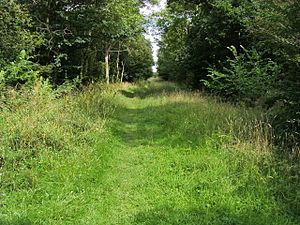Brampton Wood facts for kids
| Site of Special Scientific Interest | |
 |
|
| Area of Search | Northamptonshire |
|---|---|
| Interest | Biological |
| Area | 132.1 hectares |
| Notification | 1983 |
| Location map | Magic Map |
Brampton Wood is a large forest area covering 132.1 hectares (about 326 acres). It is located in Cambridgeshire, west of the village of Brampton. This special place is known as a Site of Special Scientific Interest (SSSI) because of its important wildlife. The Wildlife Trust for Bedfordshire, Cambridgeshire and Northamptonshire takes care of Brampton Wood.
Contents
How Brampton Wood is Cared For
For a while, Brampton Wood was used for growing trees in a planned way, called plantation forestry. In the 1950s, the Forestry Commission planted many Scots pine, Corsican pine, and Norway spruce trees. These trees were planted in neat rows. At that time, the Ministry of Defence owned the wood.
In 1992, the Ministry of Defence sold Brampton Wood. People raised money through a public appeal. This allowed the Wildlife Trust to buy the wood. Since then, the Trust has worked hard to manage the wood for wildlife.
Helping Trees and Flowers Grow
One way the wood is managed is through a method called coppicing. This means cutting down trees close to the ground. New shoots then grow from the stump. This helps many woodland flowers, birds, and insects to thrive.
However, there are many muntjac deer in Brampton Wood. These deer like to eat the young shoots. To protect the new growth, fences are sometimes put around the coppiced areas. Sometimes, cut branches are placed over the stumps to stop the deer from eating them. Another old method called pollarding might also be used. This involves cutting branches higher up the tree.
Amazing Wildlife at Brampton Wood
Brampton Wood is home to many different kinds of plants and animals. It's a great place to spot rare species.
Plants and Trees You Can Find
About 280 different types of plants, ferns, and trees have been found in Brampton Wood. Some common woodland flowers include dog's mercury, bluebell, primrose, and violets. You can also see very old, large oak trees, sometimes called 'major oaks', near the main paths.
Brampton Wood is also special because it has three wild service trees. The berries from these trees, called 'chequers', were once used to flavor beer in Britain.
Butterflies and Other Animals
Brampton Wood is famous for its large groups of black hairstreak butterflies. These are some of Britain's rarest butterflies. They survive because the paths in the wood are carefully managed. This means trimming bushes at certain times of the year so the butterflies are not disturbed. Other butterflies you might see here include the brown argus, white admiral, and purple hairstreak.
The wood is also a good home for hazel dormouses. These small, sleepy creatures were brought back to the wood in 1992. They live spread out across the wood and enjoy eating hazelnuts, brambles, and various flowers.

